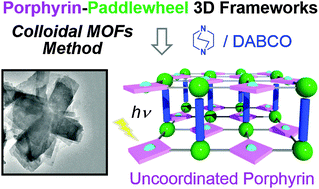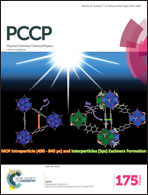Control of local structures and photophysical properties of zinc porphyrin-based supramolecular assemblies structurally organized by regioselective ligand coordination†
Abstract
Nano- and micro-sized molecular assemblies of zinc porphyrins [5,10,15,20-tetrakis(4-carboxyphenyl)porphyrinato-zinc(II) (ZnTCPP)] utilizing bridging nitrogen ligands such as diazabicycro[2.2.2]octane (DABCO) were prepared to demonstrate the regioselective coordination by two different synthetic strategies such as (i) the solvothermal method and (ii) the colloidal metal organic framework (MOF) method. The initial organization process is a planar checkerboard patterned formation (2D platform) of zinc porphyrins organized by paddlewheel secondary building units (PSBUs) between carboxylate and zinc ions. Then, DABCO moieties are decorated on zinc atoms in the metal centres of the porphyrin rings (m-cPDC) in the solvothermal method, whereas the metal centres in the porphyrin rings (n-uPDC) remain uncoordinated in the colloidal MOF method. These internal structural changes between m-cPDC and n-uPDC are in sharp contrast with the corresponding reference systems using ZnTCPP and a 4,4′-bipyridine (BPY) ligand (i.e., m-cPBC and n-cPBC). Concretely, the metal centres of zinc porphyrins in n-uPDC were unsaturated and uncoordinated with the DABCO ligands, which was confirmed by XRD and steady-state spectroscopic measurements. These different coordination features have great effect on the spectroscopic and photophysical properties. For example, the average fluorescence lifetime of m-cPDC is much smaller than that of n-uPDC because of the acceleration of nonradiative processes, which are highly related with the coordination of DABCO to the Zn(II) centre of the ZnTCPP unit. Finally, fluorescence quenching experiments via photoinduced electron transfer (PET) utilizing an electron acceptor: benzoquinone (BQ) were performed. The apparent association constant (Kapp) of n-uPDC is larger than that of m-cPDC. This suggested that the unsaturated ZnTCPP units embedded in n-uPDC easily accommodate guest molecules as compared to the other systems.


 Please wait while we load your content...
Please wait while we load your content...